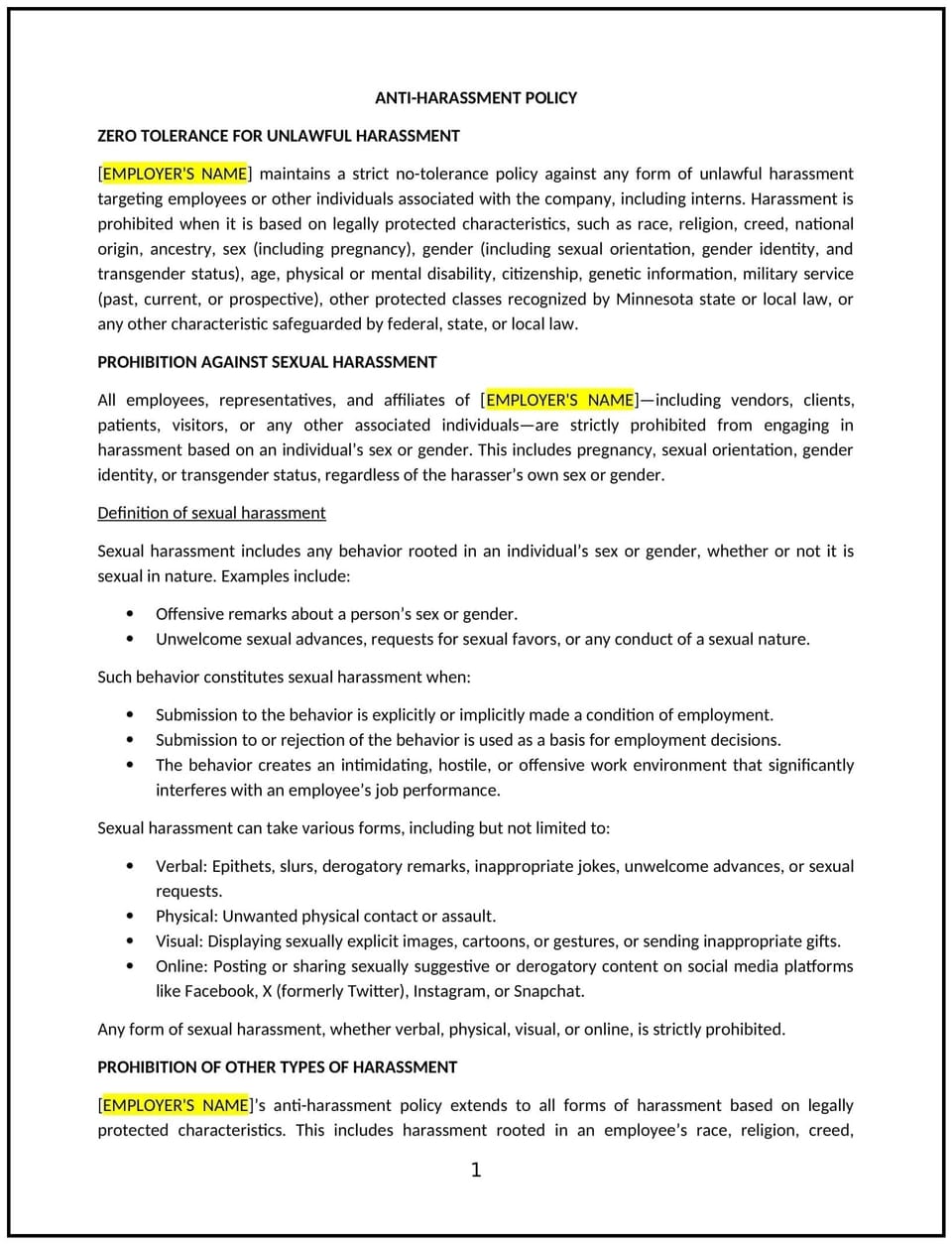Anti-harassment policy (Minnesota): Free template

Anti-harassment policy (Minnesota)
This anti-harassment policy is designed to help Minnesota businesses create a safe, respectful, and inclusive workplace for all employees. Whether businesses are addressing workplace behavior, preventing harassment, or fostering a culture of respect, this policy provides a framework to promote dignity and professionalism. Tailored to Minnesota’s legal and cultural environment, this policy emphasizes zero tolerance for harassment, discrimination, or retaliation.
By implementing this policy, businesses in Minnesota can protect employees, reduce risks, and cultivate a positive workplace culture that aligns with state and federal laws.
How to use this anti-harassment policy (Minnesota)
- Define harassment: Clearly outline what constitutes harassment, including verbal, physical, and digital forms, as well as examples of prohibited behavior.
- Establish reporting procedures: Provide employees with clear, confidential channels to report harassment or discrimination without fear of retaliation.
- Train employees and managers: Educate staff on recognizing, preventing, and addressing harassment, emphasizing the importance of a respectful workplace.
- Investigate complaints promptly: Ensure all reports of harassment are taken seriously and investigated thoroughly and impartially.
- Enforce consequences: Outline disciplinary actions for violations of the policy, ensuring consistency and fairness.
- Promote a respectful culture: Encourage open communication, mutual respect, and inclusivity in all workplace interactions.
- Review and update the policy: Regularly assess the policy’s effectiveness and make adjustments as needed to reflect changes in laws or workplace dynamics.
- Communicate the policy: Share the policy with employees during onboarding and through regular reminders, such as emails or training sessions.
Benefits of using this anti-harassment policy (Minnesota)
This policy offers several advantages for Minnesota businesses:
- Protects employees: A clear anti-harassment policy helps create a safe and respectful environment for all employees.
- Reduces legal risks: By addressing harassment proactively, businesses can minimize the risk of lawsuits and regulatory penalties.
- Enhances workplace culture: Promoting respect and inclusivity fosters a positive and productive work environment.
- Builds trust: Employees are more likely to trust leadership when they see a commitment to addressing harassment and discrimination.
- Supports compliance: The policy helps businesses align with Minnesota state laws and federal regulations, such as Title VII of the Civil Rights Act.
- Improves retention: A respectful workplace increases employee satisfaction and reduces turnover.
- Strengthens reputation: Demonstrating a commitment to a harassment-free workplace enhances the business’s reputation among employees, customers, and the community.
Tips for using this anti-harassment policy (Minnesota)
- Communicate the policy effectively: Share the policy with employees during onboarding and through regular training sessions.
- Provide anti-harassment training: Educate employees and managers on recognizing, preventing, and addressing harassment.
- Encourage reporting: Create a safe and confidential channel for employees to report harassment or discrimination.
- Investigate complaints promptly: Ensure all reports are taken seriously and addressed in a timely and impartial manner.
- Be transparent: Share updates on policy enforcement and progress in addressing harassment with employees to build trust.
- Review the policy periodically: Update the policy as needed to reflect changes in laws, workplace dynamics, or industry standards.
Q: Why should Minnesota businesses adopt an anti-harassment policy?
A: Businesses should adopt this policy to create a safe and respectful workplace, reduce legal risks, and foster a positive work environment.
Q: What behaviors are considered harassment under this policy?
A: Harassment includes unwelcome verbal, physical, or digital conduct based on protected characteristics, such as race, gender, religion, or disability.
Q: How should businesses handle harassment complaints?
A: Businesses should investigate complaints promptly, thoroughly, and impartially, and take appropriate action to address the issue.
Q: What training should businesses provide to employees?
A: Businesses should educate employees on recognizing, preventing, and addressing harassment, as well as the importance of a respectful workplace.
Q: How can businesses prevent retaliation against employees who report harassment?
A: Businesses should enforce strict anti-retaliation measures and ensure employees feel safe reporting harassment without fear of consequences.
Q: How often should the policy be reviewed?
A: The policy should be reviewed annually or as needed to reflect changes in laws, workplace dynamics, or industry standards.
Q: What role do managers play in enforcing this policy?
A: Managers should lead by example, address inappropriate behavior promptly, and ensure all employees understand and adhere to the policy.
This article contains general legal information and does not contain legal advice. Cobrief is not a law firm or a substitute for an attorney or law firm. The law is complex and changes often. For legal advice, please ask a lawyer.


